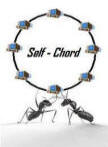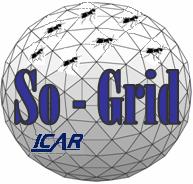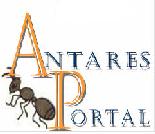
Self-Chord prototype available (free source)!
Self-Chord is a P2P system that inherits the ability of Chord-like structured systems for the construction and maintenance of an overlay of peers, but features enhanced functionalities deriving from ant-inspired algorithms, such as autonomy behavior, self-organization and capacity to adapt to a changing environment.
As opposed to the structured P2P systems deployed so far, resource indexing and placement is uncorrelated with network structure and topology, and resource keys are organized and managed by self-organizing mobile agents through simple local operations driven by probabilistic choices.
The benefits vs. classical
structured systems like Chord are essentially three:
1) Peer indexes and resource keys are uncorrelated,
which opens the possibility to give a semantic meaning
to keys and perform class (or range) queries
2) A better load balance among the peers can be obtained
3) Dynamic properties (e.g., management of joining
nodes) are improved. For example, it is not necessary to
reassign keys when new peers or resources are added to
the system: the mobile agents will spontaneously
reorganize the keys. More information can be found on
this paper:
A. Forestiero, C. Mastroianni, M. Meo, "Self-Chord: a
Bio-Inspired Algorithm for Structured P2P Systems",
CCGrid 2009 - IEEE International Symposium on
Cluster Computing and the Grid, Shanghai, China, 18-21
May 2009. Best Paper Award.
The GNU licensed Java prototype is available!

So-Grid is a set of P2P algorithms than can be
adopted for the construction of a Grid information
system.
So-Grid assumes that Grid resources are pre-categorized
in classes. To facilitate discovery operations, a number
of ant-inspired mobile agents replicate the descriptors
of the resources and accumulate the descriptors of
different classes in different regions of the network.
Grid users are allowed to issues discovery requests to
retrieve a set of resources of a specified class, and
successively can choose the most appropriate for their
use. The discovery procedure is semi-informed: at the
beginning, the search messages travel the network with a
random walk strategy. As soon as one of them approaches
a representative peer for the class of interest (i.e., a
peer that stores a large number of descriptors of that
class) the procedure becomes informed and the message is
directed towards that peer.
More information can be found on this
paper:
A. Forestiero, C. Mastroianni, G. Spezzano, "So-Grid: A
Self-organizing Grid Featuring Bio-inspired Algorithms".
ACM Transactions on Autonomous and Adaptive Systems,
vol. 3, n. 2, May 2008.
The paper is downloadble from
here.
You can also visit the
So-Grid site to run your own simulations and analyze
the behaviour of the So-Grid algorithms.

Antares is a different P2P approach for the
construction a Grid information system.
Antares is devised for a Grid in which resources are
indexed by bit keys, which are calculated with a hash
function. Resources that share common characteristics (for
example hosts having similar CPU power or memory
capacity) are mapped to the same key value. Moreover, if
a locality preserving hash function is adopted, similar
resources are assigned similar key values.
The objective of ant-inspired agents is to replicate and
move resource descriptors, and spatially sort them on
the network according to their key values. Thanks to
this sorting, a search message, issued to discover the
descriptors having a specified key, can be forwarded,
step by step, towards a region that has accumulated a
number of resource descriptors having the desired key.
The search message follows a path following the gradient
of resource keys: at each step the message is forwarded
to the neighbour peer that minimizes the distance
between the target key and the keys of the descriptors
stored in the vicinity of the peer. Therefore, with
Antares, the search procedure is completely informed.
More information can be found on this paper:
A. Forestiero, C. Mastroianni, G. Spezzano, "Antares: an
Ant-Inspired P2P Information System for a
Self-Structured Grid". BIONETICS 2007 - 2nd
International Conference on Bio-Inspired Models of
Network, Information, and Computing Systems, Budapest,
Hungary, December 2007.
The paper is downloadble from
here.
You can also visit the
Antares site to run your own simulations and analyze
the behaviour of the Antares algorithms.